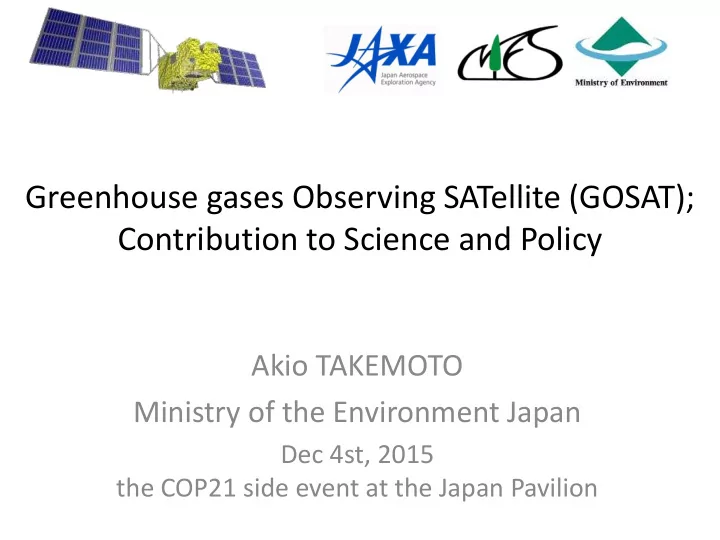

Greenhouse gases Observing SATellite (GOSAT); Contribution to Science and Policy Akio TAKEMOTO Ministry of the Environment Japan Dec 4st, 2015 the COP21 side event at the Japan Pavilion
Table of Contents • Overview of the GOSAT • Global GHGs monitoring • Observation of anthropogenic GHGs concentration – CO2 over Mega-cities comparative analysis with emission data – CH4 comparative analysis with emission data • Way forward
Greenhouse gases Observing SATellite (GOSAT); (Launch : 23 rd , Jan. 2009) - ) MOEJ : Ministry of the Shared Responsibilities Environment Japan • Supporting the undertakings of • each other Utilizing GOSAT-data for policy MOEJ • • Managing the Science Team Contributing to international efforts to • Promoting data utilization reduce carbon emissions NIES: National Institute for JAXA: Japan Aerospace Environmental Studies Exploration Agency • • Developing and improving the Developing sensors JAXA NIES • methods to derive greenhouse gas Developing, launching, and operating concentrations the satellite • • Producing , validating, and distributing Receiving and recording the the higher-level products observational data • • Estimating carbon fluxes Processing and calibrating Level 1 data
GOSAT Observation Mechanism Provided by JAXA GOSAT GHG Observation Point: ca. 13000
GOSAT Observation Advantage Earth Surface Observation Point: ca. 260 ca. 70 km GOSAT GHG Observation Point: Whole ca. 13000 atmosphere (surface to the top) http://www.satnavi.jaxa.jp/project/gosat/ 0 km http://oco.jpl.nasa.gov/images/oco/OCO_column.jpg
GOSAT in Summery • Launched in January 2009. Achievement • Measurement of the CO2,CH4 concentration with high accuracy. • To estimate sources and sinks of GHG • To contribute of climate change science such as IPCC Assessment Reports. At present still in operation despite exceeding the designed life.
Annual Trends of CO2 concentrations in the whole- atmosphere (corrected seasonal cycle) in 2009-2015 The monthly averages of CO2 reached 398.8 ppm in May 2015. The trend line is expected to exceed 400 ppm within the year 2016.
Variations of the monthly averages of CO2 (four selected months in 2009-2015) 2009 2010 2011 2013 2014 2015 2012 Jan Apr Jul Oct Ministry of the Environment Japan / JAXA / NIES It has become clear visually that an increasing trend of CO2 has been appeared as the years go by. 8
Observation of anthropogenic CO2 concentration over Mega-Cities (data used from 2009 to 2012, analyzed 1deg. grid resolution) Distribution of anthropogenic CO2 concentrations estimated from observational data acquired by GOSAT .
Observation of anthropogenic CO2 concentration over Mega-Cities (analyzed 1deg. grid resolution, data observed 2009-2012) Asia
Observation of anthropogenic CO2 concentration over Mega-Cities (analyzed 1deg. grid resolution, data observed 2009-2012) North America
Observation of anthropogenic CO2 concentration over Mega-Cities and comparative analysis with emission data North America The Globe East Asia The GOSAT has the potential to detect enhanced CO2 concentration from fossil fuel consumption in mega-cities.
Observation of anthropogenic CH4 concentration (data used from 2009 to 2012, analyzed 1deg. grid resolution) Distribution of anthropogenic CH4 concentrations estimated from observational data acquired by GOSAT .
Observation of anthropogenic CH4 concentration (data used from 2009 to 2012, analyzed 1deg. grid resolution) Distribution of anthropogenic CH4 concentrations estimated from observational data acquired by GOSAT .
Observation of anthropogenic CH4 concentration (data used from 2009 to 2012, analyzed 1deg. grid resolution) Distribution of anthropogenic CH4 concentrations estimated from observational data acquired by GOSAT .
Observation of anthropogenic CH4 concentration and comparative analysis with emission data The GOSAT has the potential to detect anthropogenic CH4 concentration.
Way Forward GOSAT-2 (JFY2017 - ) I. To launch GOSAT-2 in JFY2017 (early 2018) successively observing GHG concentrations and emissions over the earth. II. To develop an innovative tool to evaluate GHG emissions in nation, local and point source scales, through. III. To seek an international collaboration for GHG observation with multiple satellites.
Recommend
More recommend